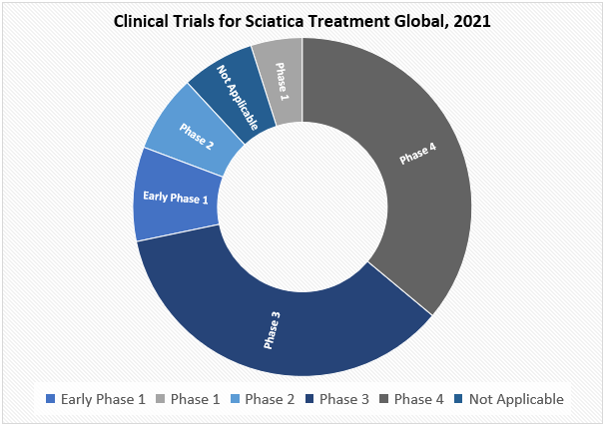Sciatica Treatment Market Seen Soaring 8.2% Growth to Reach USD 950 Million by 2030, Projects Univdatos Market Insights
- Himanshu Patni
- November 17, 2023
- HEALTHCARE, NEWS
- Sciatica Treatment Market, Sciatica Treatment Market Forecast, Sciatica Treatment Market Growth, Sciatica Treatment Market Size, Sciatica Treatment Market Trends
- 0 Comments
According to a new report by Univdatos Market Insights, the Sciatica Treatment Market is expected to reach USD 950 Million in 2030 by growing at a CAGR of 8.2%. Sciatica Treatment is a symptom of a disease or medical condition and not a condition itself. Sciatica is quite common among people of all ages but has prominence in the geriatric population. Sciatica symptoms usually occur when L4, L5, or S1 nerve roots are affected. Sciatica symptoms arising from each of these nerve roots cause pain in different areas of the body. Sciatica has been widely categorized into acute sciatica, chronic sciatica, alternating sciatica,and bilateral sciatica depending on the duration of symptoms and if one or both legs are affected by sciatica. This condition might occur due to a lumbar herniated disc, degeneration of tissues in the lumbar spine, lumbar spinal stenosis, or spondylolisthesis. Sciatica treatment can help patients get relief from painful tingling or paraesthesia, urinary and fecal incontinence, and muscle weakness. Popular drug classes related to sciatica treatment impacting the market are non-steroidal anti-inflammatory drugs (NSAIDs), steroids, antidepressants, and others (muscle relaxants, analgesics, opioids). This market is being boosted due to multiple factors like a surge in the prevalence of diseases like spine tumors and herniated discs, a rise in the geriatric population, increased expenditure in healthcare, and advancements in healthcare technologies.
Access sample report (including graphs, charts, and figures) – https://univdatos.com/get-a-free-sample-form-php/?product_id=47479
The report suggests that Rising Research and Development is one of the major factors driving the growth of the sciatica treatment market during the forthcoming years. Sciatica Treatment is mainly done using non-steroidal anti-inflammatory drugs (NSAIDs). However, multiple ongoing clinical trials have concluded the combination of drugs is more effective than only NSAIDs in treating sciatica. Clinical trials are essential for the development of new and modified models for sciatica treatment, as they provide valuable information on the effectiveness of drugs and combinations of drugs in treating sciatica. In recent years, there has been an increasing number of clinical trials focused on sciatica treatment. For instance, in November 2022, Salvatore Insinga, D.O., a neurosurgeon practicing in New York State claimed that a combination of NSAIDs such as naproxen or ibuprofen and gabapentin can be very effective in relieving sciatica and muscle spasms. They are investigating new combinations of techniques that may be more effective than existing treatment procedures. The increasing number of clinical trials for sciatica treatment is driving the growth of the market, as it indicates a greater interest in developing new treatments for painful spinal disorders. It also provides hope for patients suffering from chronic spinal disorders which cannot be completely cured but symptoms can be significantly minimized.
Fig1: Clinical Trials for Sciatica Treatment Global, 2021
Apart from this, the prevalence of minimally invasive procedures has attracted the interest of people. One such procedure called pulsed radiofrequency (RF) uses a fine needle to heat nerve roots near the spine along with epidural steroid injection treatment and is found to be helpful in reducing superior pain and improving disability in patients suffering from sciatica. In March 2023, the Radiological Society of North America published its results from recent clinical trials of pulsed radiofrequency (RF). In the procedure, healthcare practitioners use CT scans to slide a fine needle directly into the nerves that are causing sciatic pain. Later inserted needle is heated using pulses of radio waves producing heat that disrupts the nerve, preventing it from sending pain signals to the brain. Pulsed radiofrequency can relieve pain in hardly 10 minutes, with no surgical procedure, no hospitalization, and relatively faster recovery. This is definitely a smart and innovative treatment method for sciatica. Here are some key points to understand why minimally invasive procedures are gaining attention in the sciatica treatment market:
Lesser risk of contamination: Minimally invasive procedures are less likely to be exposed to contaminations that cause infections which makes such procedures better than most traditional methods.
Holding the reins: Much lower risk of surgical site infection compared to traditional methods. This might present minimally invasive procedures highly appealing as they are able to control contamination risk.
Better Quality of Life: Because they are often performed with a negligible incision at the part of the body, minimally invasive procedures may offer a better quality of life for patients by causing fewer infections compared to traditional surgeries.
Click Here To View the Report Description & TOC – https://univdatos.com/report/sciatica-treatment-market-2/
Conclusion
The global sciatica treatment market is a rapidly growing field, with advancements in treatment methods leading to improved outcomes for patients. Sciatica Treatment is a type of symptom of a medical condition that causes severe pain in nerves in the lower region of the human body. The global sciatica treatment market is expected to continue to grow in the coming years. Overall, the global sciatica treatment market represents a significant opportunity for pharmaceutical companies and professionals in the field of clinical research. With continued research and development, it is likely that even more effective treatments will become available in the future, leading to improved outcomes for patients with sciatica treatment.

